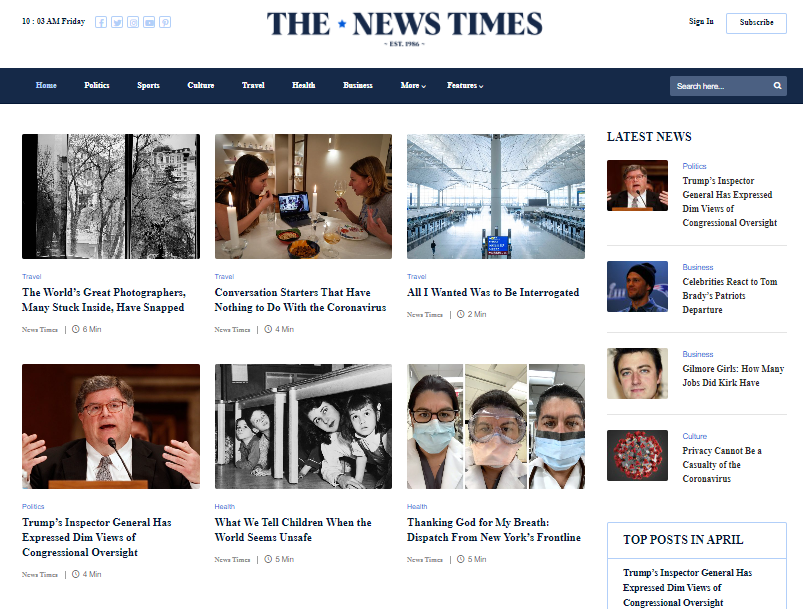The Growth of Subscription Models and How stnews.live Adapts
The Impact of Social Network en route We Eat News Online
Social network has actually fundamentally changed news intake. It supplies prompt accessibility to information, commonly eclipsing standard media outlets. This rapid dissemination comes with challenges. Customers encounter the threat of encountering misinformation and ending up being caught in resemble chambers. The formulas driving individualized content can cover diverse point of views. As these dynamics develop, understanding their implications ends up being vital for informed engagement in public discourse. What approaches might assist navigate this complex landscape?
The Advancement of News Usage in the Digital Age
As technology progressed, the method people eaten news changed considerably in the electronic age (stnews.live). Standard newspapers and relayed media began to decline as the net arised as a primary resource of details. On-line systems supplied instant access to news posts, videos, and podcasts, enabling users to stay educated at any moment. The benefit of mobile tools further increased this shift, enabling users to get updates on the go
Furthermore, the rise of news aggregators and internet sites facilitated the consumption of varied viewpoints, empowering individuals to customize their news intake based on individual rate of interests. This development also triggered wire service to adjust their methods, concentrating on electronic web content and interesting readers through multimedia styles. Consequently, the standard obstacles of time and room in news delivery diminished, causing a more prompt and personalized news experience for target markets worldwide.
The Role of Social Media Platforms in News Circulation
Social media site systems have actually transformed news circulation by giving immediate accessibility to details. Their algorithm-driven content curation commonly focuses on involvement over precision, resulting in substantial integrity challenges (stnews.live). As customers browse this landscape, the ramifications for news usage and public discourse ended up being increasingly complex
Instant News Access
Although conventional news electrical outlets have long been the main source of details, the rise of social networks systems has dramatically transformed how news is accessed and taken in. Instant news access has come to be a trademark of the digital age, allowing customers to get updates in real time. Systems such as Twitter, Facebook, and Instagram allow news to spread swiftly, often exceeding conventional media in speed and reach. Individuals can share stories, remark on occasions, and engage with reporters, developing a dynamic interaction in between the audience and news web content. This immediacy cultivates a society of urgency, prompting users to inquire quickly. The expectation for timely news has actually reshaped journalistic methods, compelling news organizations to adjust their strategies to fulfill the needs of a busy electronic atmosphere.
Algorithm-Driven Web content
While individuals proactively engage with material on social networks, the formulas that regulate these platforms play a crucial duty in identifying which newspaper article obtain presence. These algorithms assess individual behavior, choices, and engagement metrics to curate personalized news feeds. Consequently, particular stories might be amplified while others continue to be rare, usually prioritizing thrilling or trending topics over substantive reporting. This selective exposure shapes users' understandings of existing occasions and affects public discussion. The reliance on algorithm-driven content can create echo chambers, where individuals are generally subjected to point of views that straighten with their own ideas. The dynamics of news circulation on social media platforms substantially influence exactly how individuals take in and analyze information in the digital age.
Credibility Difficulties
As users increasingly transform to social media for news, the reliability of details come across on these platforms ends up being a pushing worry. The decentralized nature of social media sites enables any individual to publish content, often blurring the lines in between reliable journalism and false information. Algorithms prioritize involvement over accuracy, resulting in the widespread circulation of astonishing or misleading stories. This environment positions substantial difficulties for users trying to determine trustworthy resources. Social media site platforms, while venturing to battle misinformation with fact-checking and material moderation, run the gauntlet for inconsistencies and predispositions in their approaches. Eventually, the obligation exists with individuals to seriously review the news they take in, as the fast spread of information usually outmatches verification efforts by systems.
The Rise of Person Journalism and User-Generated Web Content
The increase of person journalism has actually encouraged daily people to share news and viewpoints, commonly offering insights that conventional media may forget. This shift likewise presents considerable obstacles, especially the spread of misinformation that can occur from unverified content. As user-generated web content becomes extra prevalent, the equilibrium in between authentic voices and precision in coverage remains a crucial issue.
Encouraging Daily Voices

Obstacles of Misinformation
While the surge of citizen journalism has opened up avenues for varied voices in the media landscape, it has additionally presented considerable difficulties associated with misinformation. The convenience of sharing information through social media platforms allows people to disseminate news quickly, yet this rapid spread frequently comes at the price of precision. User-generated material often does not have the rigorous fact-checking and content oversight that traditional journalism provides. Consequently, sensationalized or incorrect stories can gain grip, deceiving target markets and shaping public understanding (stnews.live). The mixing of viewpoint and reality within social media makes complex the difference in between reliable details and misinformation. Therefore, consumers have to navigate an increasingly intricate media environment, calling for vital believing skills to recognize reliable news resources amidst the noise

Misinformation and Its Effects for Public Discourse
As social media systems progressively control the landscape of information circulation, the proliferation of false information positions significant difficulties for public discussion. Misinformation, typically developed to mislead or prompt psychological reactions, can distort assumptions of fact and threaten depend on in legitimate sources. This phenomenon leads to polarized point of views, as individuals are attracted in the direction of echo chambers that reinforce their beliefs, additionally setting divisions within culture.
The effects for public discourse are extensive. When people depend on incorrect information, significant discussion decreases, and the autonomous procedure experiences. Misinformation can incite anxiety and complication, influencing public health and wellness, read security, and political security. As a result, promoting media proficiency becomes essential, encouraging people to critically assess information and determine fact from fiction. Attending to the obstacles presented by misinformation is important for preserving the honesty of public discussion and ensuring a well-informed people with the ability of taking part in useful conversations.
The Impact of Algorithms on News Presence
Given the central duty of algorithms in figuring out material exposure, their influence on news consumption is extensive. These formulas, made use of by social networks platforms, focus on certain kinds of web content based upon user engagement and preferences. Because of this, newspaper article that line up with preferred trends or audience rate of interests are most likely to be presented prominently, while much less sensational stories may be neglected. This creates a setting where customers are exposed mainly to info that reinforces their viewpoints, possibly bring about resemble chambers.
Additionally, the consistent evolution of algorithms indicates that news organizations must adapt their methods to line up with these altering parameters, frequently focusing on clickbait or psychologically charged headlines. As a result, the stability of news coverage can be jeopardized, as important tales might not receive the presence they are entitled to. The algorithmic page shaping of news visibility consequently plays an important role in affecting public understanding and understanding of existing occasions.
The Shift Towards Aesthetic Storytelling in News Media
Progressively, news media is accepting visual narration as a powerful device to involve target markets. This strategy leverages pictures, videos, infographics, and interactive aspects to convey info better than typical text-based formats. As interest covers reduce, visuals supply a quick, impactful way to connect intricate tales and grab audiences' rate of interest.
Systems like Instagram and TikTok have additional accelerated this pattern, engaging wire service to adapt their web content methods to fit these visually-driven environments. By incorporating compelling visuals, news electrical outlets can boost emotional connections and foster higher understanding of topical issues.
In addition, visual narration enables more varied stories, showcasing multiple point of views via vibrant presentations. As target markets progressively consume news via mobile tools, the shift towards visuals not only deals with customer choices however also helps to damage down barriers to info access. Eventually, this advancement shows a broader makeover in just how news is generated and consumed in the digital age.
Future Patterns: Browsing the Altering Landscape of News Usage
While the electronic landscape remains to evolve, news intake is poised for considerable transformation driven by arising technologies and changing target market actions. As synthetic intelligence and machine knowing development, personalized news feeds will become extra prevalent, enabling individuals to obtain material customized to their interests. This modification can cause better interaction but additionally elevate concerns concerning resemble chambers and misinformation.
Moreover, the surge of voice-activated devices and clever speakers will affect how news is provided, shifting the focus from aesthetic to acoustic layouts. This pattern may urge wire service to embrace more concise and appealing audio web content.

Often Asked Questions
Exactly How Do Social Network Communications Affect News Reliability?
Social media site interactions can considerably affect perceptions of news reputation. Engagement metrics, such as likes and shares, frequently form target market trust, with preferred messages getting perceived authenticity, despite the accuracy or reliability of the details presented.
What Duty Do Influencers Play in Shaping News Narratives?
Influencers considerably form news narratives by leveraging their systems to magnify particular stories, usually tailoring content to their audience. This can result in biased point of views, impacting public perception and prioritizing sensationalism over valid reporting.
Exactly How Can Users Identify Reliable News Resources on Social Media Site?
Customers can recognize dependable news sources on social networks by examining the resource's reputation, validating realities through multiple outlets, assessing the professionalism and reliability of the content, and identifying possible biases in reporting to assure accurate info.
What Impact Does Social Media Have on Traditional Journalism Jobs?
Social network greatly affects standard journalism work by changing profits designs, minimizing need for print media, and promoting competitors from resident journalists. Several experts face task instability and need to adapt to quickly altering media landscapes.
Just How Do Different Demographics Consume News on Social Media Site?
Various demographics show different preferences for news intake on social media sites. Younger audiences prefer platforms like TikTok and Instagram for fast updates, while older people often tend to prefer Twitter and facebook for more in-depth discussions and write-ups.